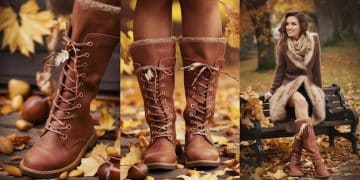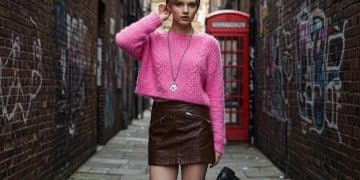Vintage Clothing Shopping: Tips for Unique & Affordable Finds
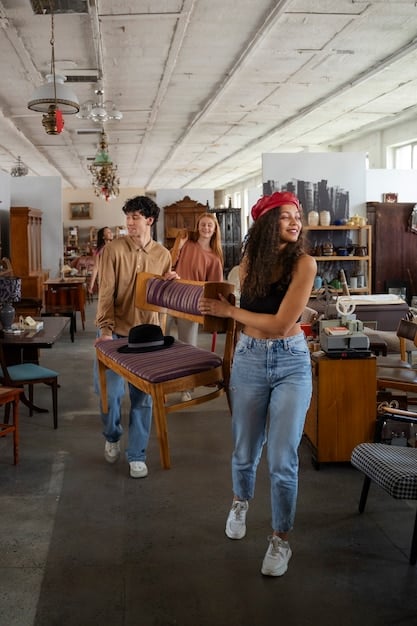
Shopping for vintage clothing offers a unique way to express your style while being sustainable and budget-conscious, requiring a keen eye and knowledge of where to find the best pieces.
Discovering the allure of vintage clothing is like embarking on a treasure hunt, filled with unique finds and the thrill of owning a piece of history. But how do you navigate the world of thrift stores, online marketplaces, and vintage boutiques to find authentic, stylish, and affordable pieces? This guide on how to shop for vintage clothing: tips for finding unique and affordable pieces will equip you with the knowledge and strategies you need to build a standout vintage wardrobe.
Understanding the Allure of Vintage Fashion
Vintage fashion has surged in popularity, driven by a desire for individuality, sustainability, and a connection to past eras. More than just wearing old clothes, it’s about embracing stories, craftsmanship, and styles that have stood the test of time.
Before heading out to shop for vintage, it’s important to understand what makes it so appealing. Appreciation for unique styles and historical significance is key.
The Definition of Vintage
Understanding the term “vintage” sets the stage. Typically, clothing from the 1920s to the 1990s is considered vintage, while items older than that are often referred to as antique. Knowing these distinctions helps when searching for specific pieces or eras.
Why Choose Vintage?
There are many reasons people gravitate toward vintage: sustainability, unique style, and affordability. Fast fashion contributes significantly to environmental waste, while vintage offers a more eco-friendly option. Each vintage piece tells a story and adds character to your wardrobe, and many vintage finds are more affordable than new designer items.
- Sustainability: Reduces textile waste and supports eco-conscious fashion.
- Unique Style: Expresses individuality through one-of-a-kind pieces.
- Affordability: Offers budget-friendly alternatives to contemporary fashion.
In summary, understanding the allure of vintage fashion involves appreciating its historical context, recognizing its sustainability benefits, and embracing the opportunity to express personal style through unique and affordable pieces.
Identifying Quality Vintage Pieces
Knowing how to assess the quality of vintage clothing is crucial to ensure that you are investing in pieces that will last. Carefully examining the construction, fabric, and any signs of wear and tear will help you make informed decisions.
Whether you are a seasoned collector or a newbie, knowing quality signals longevity and value.
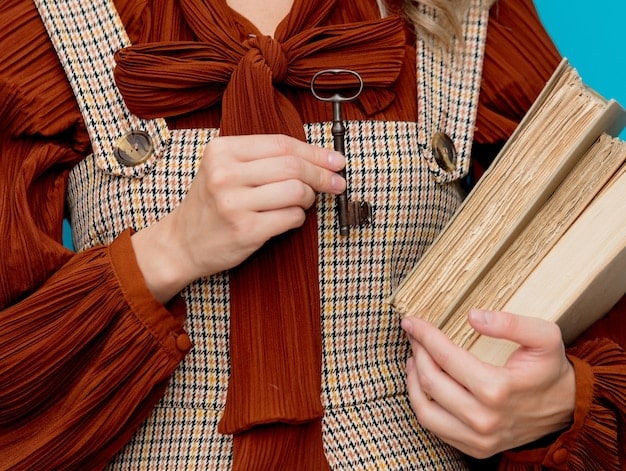
Examining Fabric and Construction
Vintage clothing often features high-quality fabrics and meticulous construction that are rare in modern fast fashion. Look for durable materials like wool, silk, and cotton. Check seams, buttons, and zippers for sturdiness.
Spotting Flaws and Damage
Vintage items may have flaws due to age and previous wear. Inspect for stains, tears, or alterations. Small issues like missing buttons are easily fixed, but significant damage may impact the item’s value and wearability.
- Check seams for loose threads or fraying.
- Look for stains, holes, or discoloration.
- Assess the condition of zippers, buttons, and closures.
In conclusion, identifying quality vintage pieces involves a keen eye for fabric, construction, and potential flaws. Taking the time to assess these elements will help you curate a vintage collection that is durable, stylish, and valuable.
Navigating Vintage Shopping Locations
The quest for the perfect vintage piece can lead you to various locations, each with its own unique offerings and atmosphere. Knowing where to shop can significantly enhance your chances of finding hidden gems.
Vintage treasures can be found in places you might not expect – from local flee markets to online hubs.
Thrift Stores and Charity Shops
Thrift stores are often the most budget-friendly option, offering a wide range of styles and brands at affordable prices. Be prepared to sift through racks of clothing, and remember that the inventory changes regularly.
Vintage Boutiques and Consignment Shops
Vintage boutiques curate their collections more carefully, ensuring that items are in good condition and often feature higher-end brands. Consignment shops offer a mix of contemporary and vintage items, typically from individual sellers.
Online Marketplaces and Auctions
Online platforms like Etsy, eBay, and specialized vintage websites provide access to a global marketplace. Utilize keywords and filters to narrow your search, and always review seller ratings and return policies.
- Thrift Stores: Budget-friendly, wide selection, regular inventory changes.
- Vintage Boutiques: Curated collections, higher-end brands, better condition.
- Online Marketplaces: Global access, extensive selection, review seller ratings.
In essence, navigating vintage shopping locations involves exploring a range of options, from thrift stores to online marketplaces. Each location offers unique opportunities and challenges, so knowing where to look can make all the difference.
Setting a Budget and Negotiating Prices
Before embarking on a vintage shopping spree, setting a budget is crucial to avoid overspending, as this helps with negotiating prices to ensure you are getting the best deals on your vintage finds.
Having a financial plan ensures that you can enhance your wardrobe without exceeding your budget.
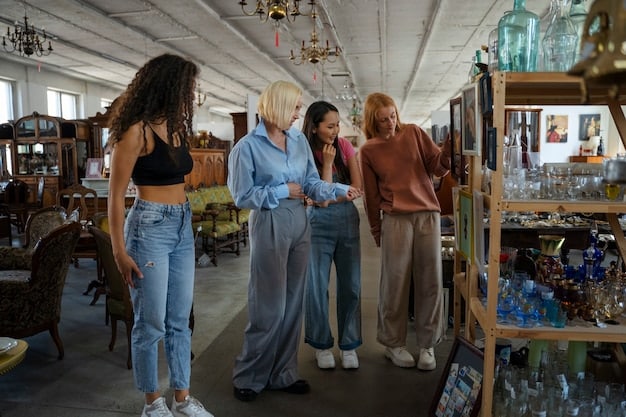
Determining Your Spending Limit
Assess your financial situation and decide how much you can comfortably spend on vintage clothing. It is advisable to allocate a specific amount each month to prevent impulse purchases that you might later regret.
Strategies for Negotiating Prices
Negotiation is a common practice in vintage shopping. Be respectful, polite, and knowledgeable about the item’s worth. Point out any flaws or damage to justify a lower price. Bundling multiple items can also lead to discounts.
Avoiding Overspending
To avoid overspending, create a list of items you need and stick to it. Compare prices across different stores and online platforms. Resist the urge to buy items simply because they are on sale or seem like a good deal.
- Research prices beforehand to know the item’s value.
- Bundle multiple items for potential discounts.
- Consider the cost of repairs or alterations when negotiating.
Concisely, setting a budget and negotiating prices are key components of smart vintage shopping. By managing your spending and negotiating effectively, you can build a unique and affordable wardrobe.
Styling and Caring for Vintage Clothing
Once you have acquired your vintage pieces, styling and caring for them properly ensures they remain in excellent condition. Knowing how to integrate vintage items into your wardrobe and maintain their quality is essential.
Proper care and styling preserve unique style and historical integrity.
Incorporating Vintage into Modern Outfits
Vintage clothing can be seamlessly integrated into contemporary wardrobes. Combine vintage tops with modern jeans, or pair a vintage dress with current accessories. Mixing eras creates an eclectic and stylish look.
Cleaning and Storing Vintage Items
Delicate cleaning is crucial to preserve the integrity of vintage fabrics. Hand wash delicate items or use a gentle machine cycle. Store clothing in a cool, dry place away from direct sunlight to prevent damage.
Repairing and Altering Vintage Pieces
Minor repairs, such as reattaching buttons or mending seams, can extend the life of your vintage clothing. Alterations can also improve the fit and style of vintage items. Consider hiring a professional tailor experienced in vintage garments.
- Hand washing and gentle machine cycles for cleaning.
- Proper storage away from sunlight and moisture.
- Professional tailoring for alterations and repairs.
In conclusion, styling and caring for vintage clothing involves creative integration into modern outfits, careful cleaning and storage practices, and necessary repairs and alterations. By following these guidelines, you can enjoy your vintage collection for years to come.
Ethical Considerations in Vintage Shopping
As the popularity of vintage fashion grows, considering the ethical implications of your shopping habits becomes important. Support sustainable practices and contribute to a more responsible fashion industry.
Ethical shopping choices support sustainability and fair labor practices.
Supporting Sustainable Practices
Vintage shopping inherently supports sustainability by giving clothing a second life and reducing the demand for new production. Emphasize vintage to reduce textile waste and its harsh impact to the environment.
Avoiding Exploitation of Labor
Investigate the origins of vintage items to ensure they were not produced under exploitative labor conditions. Some vintage boutiques and sellers prioritize ethically sourced pieces, so supporting these businesses is a good starting point.
Promoting Inclusivity and Diversity
Vintage fashion should be accessible and inclusive, and there is a growing awareness of the importance of representing diverse body types and cultural backgrounds in vintage collections. Seek out retailers that promote inclusivity and celebrate diversity.
- Support businesses that prioritize ethical sourcing.
- Choose vintage to reduce fast fashion consumption.
- Seek out shops offering inclusive sizing and diverse representation.
In summary, ethical considerations in vintage shopping encompass supporting sustainable practices, avoiding labor exploitation, and promoting inclusivity and diversity. By making informed and responsible choices, you can contribute to a more ethical and sustainable fashion industry.
| Key Point | Brief Description |
|---|---|
| 🔍 Quality Check | Inspect fabric, seams, and closures for durability. |
| 🛍️ Shopping Locations | Explore thrift stores, boutiques, and online marketplaces. |
| 💰 Budgeting | Set a spending limit and negotiate prices. |
| 👗 Styling & Care | Incorporate vintage into modern outfits and clean carefully to preserve. |
FAQ
▼
Vintage clothing typically refers to items from the 1920s to the 1990s, characterized by styles and materials distinct from contemporary fashion.
▼
Great options include thrift stores, vintage boutiques, consignment shops, and online marketplaces like Etsy and eBay, each offering different selections and price points.
▼
Inspect fabric, seams, closures, and linings for wear and tear. Look for durable materials and sturdy construction indicative of well-made garments.
▼
Mix vintage pieces with modern items to create an eclectic look that balances the old and new. Accessorize with contemporary belts, shoes, or bags to update the vintage style.
▼
Hand wash delicate items with mild soap or use a gentle machine cycle. Store clothing in a cool, dry place away from direct sunlight and consider professional cleaning for intricate or damaged pieces.
Conclusion
With this knowledge on how to shop for vintage clothing, you can now confidently embark on your unique journey to find truly unique and affordable pieces. Armed to the teeth with this information, you can successfully blend sustainable practices, personal style, and ethical considerations to craft a wardrobe that not only looks great but also tells a compelling story.

